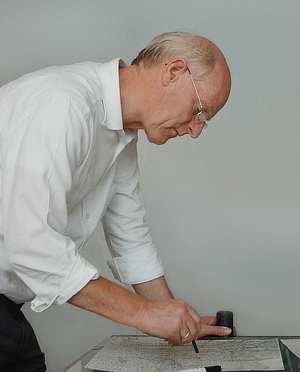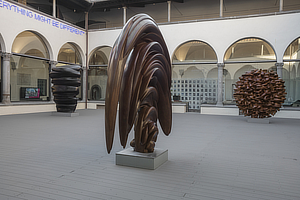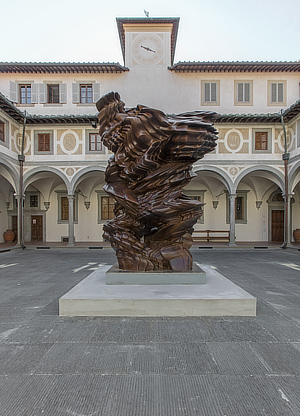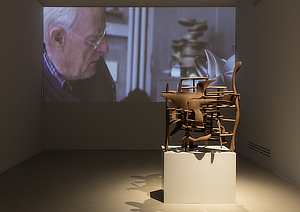 |
 |
 |
 |
 |
 |
| |
 |
|
 |
 |
 |
  |
  |
 |
 |
 |
 |
|
 |
|
 |
 |
 |
NOTE BIOGRAFICHE |
 |
|  |
|
 |
 |
 |
| |
 |
 Dopo il diploma lavora per due anni come tecnico di laboratorio nel campo della ricerca biochimica. Durante questo periodo inizia a disegnare e viene ammesso nel 1969 al Gloucestershire College of Art and Design e successivamente alla Wimbledon School of Art. Nel 1973 si iscrive al Royal College of Art di Londra, dove si concentra prevalentemente sulla scultura. Prima di iniziare a lavorare con materiali tradizionali come la pietra, il ferro e il bronzo, le sue opere sono concepite come assemblaggi di elementi di scarto e objets trouvés, e la sua ricerca risente dell'influenza del Minimalismo e della Land Art. Nel 1976 inizia ad insegnare all'École des Beaux-Arts di Metz e l'anno successivo si trasferisce a Wuppertal, città natale della sua prima moglie, dove ancora oggi vive e dove ha fondato nel 2008 lo Skulpturenpark Waldfrieden, un parco di sculture all'aperto che espone opere di molti artisti contemporanei, tra cui le sue. Dal 1978 al 1988 è docente all'Accademia d'Arte di Düsseldorf, successivamente è a Berlino all'Università delle Arti dove insegna scultura e nel 2006 a Düsseldorf all’Accademia d’Arte, dove è stato direttore dal 2009 al 2014.
Dal 1977 in poi il suo lavoro è stato presentato nei maggiori musei e istituzioni del mondo, le sue opere sono entrate a far parte delle più importanti collezioni d’arte pubblica e privata. È stato più volte rappresentato alla Biennale di Venezia e alla Documenta di Kassel, nonché alle biennali di San Paolo e Sydney. Nel 1988 gli è stato assegnato il Turner Prize. Dopo aver ricevuto diversi dottorati onorari e molti altri eminenti premi, è stato nominato nel 2003 comandante dell'Impero britannico. Nel 2007 gli è stato conferito il Praemium Imperiale dalla Corte Imperiale giapponese in quanto uno dei maggiori scultori odierni. |
|
 |
 |
 |
OPERE |
 |
|
 |
|
 |
 |
 |
|
|
 |
|
|
  Paesi Bassi [Nederland]
Paesi Bassi [Nederland]
» Den Bosch/'s Hertogenbosch |
|
|
 |
 |
 |
 |
BIBLIOGRAFIA |
 |
|
|
 |
|
 |
 |
 |
 |
 |
 |
| SCRITTI SULL'AUTORE |
 |
|
|
 |
| Tony Cragg. Material thoughs, Electa, Milano 2007 |
|
|
| Tony Cragg. Signs of Life, Electa Mondadori, 2003 |
|
 |
 |
 |
 |
MOSTRE |
 |
|
|
 |
|
 |
 |
 |
|
|
 |
Transfer, Firenze [Florence] (Italy), Museo Novecento Firenze, Istituto degli Innocenti, 23 september 2022 / 15 january 2023
 On the occasion of Florence Art Week, the Museo Novecento is hosting one of the greatest international sculptors, Tony Cragg (Liverpool, 1949). His extensive monographic exhibition, Transfer, curated by Sergio Risaliti and Stefania Rispoli, runs from 22 September 2022 to 15 January 2023, and presents a selection of sculptures and works on paper by the English master. His is particularly well-known for helping to revive the language of sculpture by introducing new materials and techniques, some of the most experimental and innovative of our time. The project is absolutely unprecedented, designed as a mediation tool to present not only the artist's works (sculptures and drawings) but also show his creative process. This special experience brings the visitor closer to contemplating and interpreting a world of original forms that amplify perceptions and imaginings between the natural world and artificial invention, between the organic and the technological. It is a chance to learn more about the work of a master who opened up new and unprecedented possibilities of expression in art, new strands of research and courageous experimentation with materials, technologies and sources of inspiration that have influenced generations of artists from the 1970s to the present. On the occasion of Florence Art Week, the Museo Novecento is hosting one of the greatest international sculptors, Tony Cragg (Liverpool, 1949). His extensive monographic exhibition, Transfer, curated by Sergio Risaliti and Stefania Rispoli, runs from 22 September 2022 to 15 January 2023, and presents a selection of sculptures and works on paper by the English master. His is particularly well-known for helping to revive the language of sculpture by introducing new materials and techniques, some of the most experimental and innovative of our time. The project is absolutely unprecedented, designed as a mediation tool to present not only the artist's works (sculptures and drawings) but also show his creative process. This special experience brings the visitor closer to contemplating and interpreting a world of original forms that amplify perceptions and imaginings between the natural world and artificial invention, between the organic and the technological. It is a chance to learn more about the work of a master who opened up new and unprecedented possibilities of expression in art, new strands of research and courageous experimentation with materials, technologies and sources of inspiration that have influenced generations of artists from the 1970s to the present.
 All of Tony Cragg's artistic research can be interpreted as a tribute to the infinite possibilities of form and that unlimited variety of solutions that only art, with nature, can evoke. All of Tony Cragg's artistic research can be interpreted as a tribute to the infinite possibilities of form and that unlimited variety of solutions that only art, with nature, can evoke.
His earliest works, dating back to the late 1970s – an era of Minimalism, Conceptual Art, Land Art and Arte Povera - are assembled from common objects (such as tools, furniture, small artefacts and discarded materials) and influenced by the tradition of Duchamp's ready-made and the Surrealist object trouvè. Later, his practice began to show the influence of philosophical studies and scientific research, leading him to experiment with the materials (bronze, resins, steel, plastic, chalk, wood, glass, household and industrial objects, organic and synthetic ones) and make sculptures that still combine craftsmanship with technology today, often using robotics.
In his works, Cragg draws from an inexhaustible source of inspiration by observing our surroundings: from nature with its organic compositions, to the crystalline structures of minerals; from digitally processed images to products artificially created in the laboratory; from archaeology to geology; from the history of art to biology. “Nature has produced wonderfully intricate shapes and structures for millions of years... it’s a diversity that fascinates me. We, on the other hand, produce rather simple, repetitive, easily reproducible shapes based on simple geometries”. This extreme curiosity for the ‘forms of the world’, whether natural or man-made, and faith in the expressive capacities of art, translates into an experimentation that sets no limits and is continuously seeking new visions. The sculptures are generated by a root, a central structure that supports them, from which they unfold to generate many different branches, imitating what nature does with its forms: "I want to make a work that has the same intense effect that looking at Nature has on me. In this sense, I was fascinated by how the rational constructions underlying the forms translate into emotional qualities". In the artistic process, Cragg continually takes, creates, manipulates and distorts the form, giving life to semantically ambiguous sculptures that, positioned between abstraction and figuration, can evoke complex natural landscapes, like the inlets of fjords, as well as giving us the illusion of representing a human figure or a familiar object.
 The exhibition Transfer is a tribute to sculpture, that magnificent obsession that has been with Cragg from the outset. In fact, the exhibition rooms host a selection of small and medium-sized works as well as drawings and watercolours, to give an idea of his prolific and multifaceted practice. Organised according to stylistic and formal criteria, the more than hundred works reveal a coherence and organic quality inherent to all of Cragg's work, showing an expressive language meticulously constructed over the years based on the idea that the creative process is also a journey of discovery. The artist always uses the same procedure – from the drawing to the choice of materials, experimentation with the technique, to the selection of the colour – working with the material and learning from it and its reactions. This way, the work unfolds only step by step in its making, revealing the infinite possibilities of form. The exhibition Transfer is a tribute to sculpture, that magnificent obsession that has been with Cragg from the outset. In fact, the exhibition rooms host a selection of small and medium-sized works as well as drawings and watercolours, to give an idea of his prolific and multifaceted practice. Organised according to stylistic and formal criteria, the more than hundred works reveal a coherence and organic quality inherent to all of Cragg's work, showing an expressive language meticulously constructed over the years based on the idea that the creative process is also a journey of discovery. The artist always uses the same procedure – from the drawing to the choice of materials, experimentation with the technique, to the selection of the colour – working with the material and learning from it and its reactions. This way, the work unfolds only step by step in its making, revealing the infinite possibilities of form.
The works located between the ground floor and the first floor of the Museo Novecento are flanked by the first three monumental sculptures exhibited in the cloister of the museum (Versus, Masks, Spring) and one in the Cortile degli Uomini at the Istituto degli Innocenti (Stack), in a dialogue with the architecture of the places, conceived in the Renaissance as environments intended for withdrawal and meditation. Once again, the Museo Novecento and one of the oldest city institutions are working together in the name of contamination between the ancient and the contemporary, between the past and present of art.
The exhibition is conceived as a mediation tool as well as an exhibition, aimed at recounting the artist's creative process and working method. In this sense, the rooms on the second floor host a number of drawings conceived as basic preparatory tools for making the sculpture, while those on the ground floor, through the staging, the artist's studio, replicate a place of creation but also life. In Wuppertal in Germany, where he moved at the end of the 1970s, Cragg created a design space conceived as a veritable citadel of art, a scientific laboratory with technicians and artisans working simultaneously on several pieces and taking turns in workshops testing the limits and capabilities of techniques and materials. Not far from there, in 2008, he founded the Skulpturenpark Waldfrieden, an outdoor sculpture park that exhibits works by many contemporary artists, including his own, bearing witness to his ongoing dedication to sculpture in the broadest sense. |
|
|
| Dalla sabbia, opere in vetro. Tony Cragg, Milano [Milan] (Italy), BuildingBox, 15 february / 16 march 2020 |
|
|
| Tony Cragg a Boboli, Firenze [Florence] (Italy), Giardino di Boboli, 5 may / 27 october 2019 |
|
|
Tony Cragg. IN 4D dal fluire alla stabilità
Venezia, Ca' Pesaro, Fondazione Musei Civici di Venezia,30 august 2010/9 january 2011
Merano/Meran, KunstMeran/Merano Arte, 5 february 2011/28 may 2011 |
|
|
| Tony Cragg. Signs of Life, Roma [Rome] (Italy), MACRO (Museo di Arte contemporanea), 6 june/7 september 2003 |
|
 |
  |
 |
|
|